0 ratings0% found this document useful (0 votes)
50 viewsAlgorithms and Complexity Lect 1
The document discusses algorithms and complexity. It defines algorithms, their characteristics, and complexity. Complexity measures the time and space required by an algorithm. Factors that affect runtime are described. Applications of complexity theory to problem classification are covered.
Uploaded by
Arvin HipolitoCopyright
© © All Rights Reserved
Available Formats
Download as PPTX, PDF, TXT or read online on Scribd
0 ratings0% found this document useful (0 votes)
50 viewsAlgorithms and Complexity Lect 1
The document discusses algorithms and complexity. It defines algorithms, their characteristics, and complexity. Complexity measures the time and space required by an algorithm. Factors that affect runtime are described. Applications of complexity theory to problem classification are covered.
Uploaded by
Arvin HipolitoCopyright
© © All Rights Reserved
Available Formats
Download as PPTX, PDF, TXT or read online on Scribd
You are on page 1/ 10
Algorithms and Complexity
Disadvantages of Algorithms
1. Algorithms is Time consuming.
2. Difficult to show Branching and Looping in Algorithms.
3. Big tasks are difficult to put in Algorithms.
Characteristics of Algorithms
1. Precision – the steps are precisely stated(defined).
2. Uniqueness – results of each step are uniquely defined and only depend
on the input and the result of the preceding steps.
3. Finiteness – the algorithm stops after a finite number of instructions are
executed.
4. Input – the algorithm receives input.
5. Output – the algorithm produces output.
6. Generality – the algorithm applies to a set of inputs.
What is Complexity?
Complexity is used to characterize something with many parts where
those parts interact with each other in multiple ways.
or
Complexity is that property of a model which makes it difficult to
formulate its overall behavior in a given language, even when given
reasonably complete information about its atomic components and their
inter-relations.
Complexity of an Algorithm
Complexity of an algorithm is a measure of the amount of time and/or
space required by an algorithm for an input of a given size (n).
What effects run time of an algorithm?
(a) computer used, the hardware platform
(b) representation of abstract data types (AD T’s)
(c) efficiency of compiler
(d) competence of implementer (programming skills)
(e) complexity of underlying algorithm
(f) size of the input
Applications of Complexity
Computational complexity theory is the study of the complexity of
problems—that is, the difficulty of solving them. Problems can be classified
by complexity class according to the time it takes for an algorithm—usually a
computer program—to solve them as a function of the problem size. Some
problems are difficult to solve, while others are easy.
For example, some difficult problems need algorithms that take an
exponential amount of time in terms of the size of the problem to solve. Take
the traveling salesman problem, it can be solved in time O(n^2 2^n) (where
n is the size of the network to visit—let's say the number of cities the
traveling salesman must visit exactly once). As the size of the network of
cities grows, the time needed to find the route grows (more than)
exponentially.
Even though a problem may be computationally solvable in principle,
in actual practice it may not be that simple. These problems might require
large amounts of time or an inordinate amount of space. Computational
complexity may be approached from many different aspects.
Computational complexity can be investigated on the basis of time,
memory or other resources used to solve the problem. Time and space
are two of the most important and popular considerations when problems
of complexity are analyzed.
Thank you
Prepared by:
Miss Marie Celia R. Aglibot
Instructor
You might also like
- Principles of Programming Languages (Pe1)No ratings yetPrinciples of Programming Languages (Pe1)2 pages
- Data Structures and Algorithms: Asymptotic NotationsNo ratings yetData Structures and Algorithms: Asymptotic Notations28 pages
- CSC 409 Algorithms and Complexity AnalysisNo ratings yetCSC 409 Algorithms and Complexity Analysis223 pages
- Syllabus Algorithms and Complexity AY 2021-2022100% (1)Syllabus Algorithms and Complexity AY 2021-20228 pages
- Ccs0003 Computer Programming 1 Lec SyllabusNo ratings yetCcs0003 Computer Programming 1 Lec Syllabus6 pages
- CS449 - Syllabus-Algorithms & ComplexityNo ratings yetCS449 - Syllabus-Algorithms & Complexity5 pages
- Introduction To Programming Languages and CompilationNo ratings yetIntroduction To Programming Languages and Compilation49 pages
- OOPJ2 - Module 1 - Introduction To Object Oriented ProgrammingNo ratings yetOOPJ2 - Module 1 - Introduction To Object Oriented Programming76 pages
- Topic 3 - Approaches To Implementing Information AssuranceNo ratings yetTopic 3 - Approaches To Implementing Information Assurance22 pages
- ITEC 205 Information Management: Information and Decision MakingNo ratings yetITEC 205 Information Management: Information and Decision Making42 pages
- Lecture 1 - Introduction To Event Driven Programming100% (1)Lecture 1 - Introduction To Event Driven Programming27 pages
- Computer Fundamentals & Programming (Exercise)No ratings yetComputer Fundamentals & Programming (Exercise)4 pages
- Core PHP (Duration 20-22 Classes) Topics: PHP, Mysql, Javascript0% (1)Core PHP (Duration 20-22 Classes) Topics: PHP, Mysql, Javascript6 pages
- Asra College of Engineering & Technology: Faculty/Course DetailsNo ratings yetAsra College of Engineering & Technology: Faculty/Course Details10 pages
- Inte 30013 Bsit Obe Format Programming 3 Structured ProgrammingNo ratings yetInte 30013 Bsit Obe Format Programming 3 Structured Programming6 pages
- Introduction To Program Logic FormulationNo ratings yetIntroduction To Program Logic Formulation39 pages
- COEN 3134 - Logic Circuits and Switching Theory Syllabus - CANSINONo ratings yetCOEN 3134 - Logic Circuits and Switching Theory Syllabus - CANSINO4 pages
- 01 - Thesis and Capstone Project Quick Outline V3.0No ratings yet01 - Thesis and Capstone Project Quick Outline V3.02 pages
- Introduction To Computing (CSEN1201) Syllabus100% (1)Introduction To Computing (CSEN1201) Syllabus2 pages
- Equity of Cybersecurity in the Education System: High Schools, Undergraduate, Graduate and Post-Graduate Studies.From EverandEquity of Cybersecurity in the Education System: High Schools, Undergraduate, Graduate and Post-Graduate Studies.No ratings yet
- Data Governance for Tax Administrations: A Practical GuideFrom EverandData Governance for Tax Administrations: A Practical GuideNo ratings yet
- Big Data - Challenges for the Hospitality Industry: 2nd EditionFrom EverandBig Data - Challenges for the Hospitality Industry: 2nd EditionNo ratings yet
- Design and Analysis of Algorithm Course Code: 5009No ratings yetDesign and Analysis of Algorithm Course Code: 500950 pages
- 1. Fundamentals of algorithms and data structuresNo ratings yet1. Fundamentals of algorithms and data structures9 pages
- Algorithms and Complexity: This Distinction Is Nicely Described in David Marr's Book, VisionNo ratings yetAlgorithms and Complexity: This Distinction Is Nicely Described in David Marr's Book, Vision8 pages
- Bismillah-e-Rahman-e-Raheem: Complexity of Algorithm and Cost - Time Trade OffNo ratings yetBismillah-e-Rahman-e-Raheem: Complexity of Algorithm and Cost - Time Trade Off14 pages
- CSC 344 - Algorithms and Complexity: Lecture #5 - SearchingNo ratings yetCSC 344 - Algorithms and Complexity: Lecture #5 - Searching31 pages
- CSC 344 - Algorithms and Complexity: Lecture #3 - Internal SortingNo ratings yetCSC 344 - Algorithms and Complexity: Lecture #3 - Internal Sorting33 pages
- 19 Century Philippines As Rizal's Context: The Life and Works of RizalNo ratings yet19 Century Philippines As Rizal's Context: The Life and Works of Rizal10 pages
- Mathematical Optimization: Recursive Bellman EquationNo ratings yetMathematical Optimization: Recursive Bellman Equation1 page
- Dynamic Programming Is Both A: Mathematical Optimization Richard Bellman Aerospace Engineering Economics RecursiveNo ratings yetDynamic Programming Is Both A: Mathematical Optimization Richard Bellman Aerospace Engineering Economics Recursive1 page
- Republic Act 1425: The Life and Works of RizalNo ratings yetRepublic Act 1425: The Life and Works of Rizal6 pages
- (FREE PDF Sample) Professional C++ Gregoire Ebooks100% (16)(FREE PDF Sample) Professional C++ Gregoire Ebooks62 pages
- Toc Lab Experiment List: (Java Formal Languages and Automata Package)100% (1)Toc Lab Experiment List: (Java Formal Languages and Automata Package)43 pages
- Scalable and Parallel Optimization of The Number Theoretic Transform Based On FPGANo ratings yetScalable and Parallel Optimization of The Number Theoretic Transform Based On FPGA14 pages
- Optimal Scheduling Algorithm For Distributed-Memory MachinesNo ratings yetOptimal Scheduling Algorithm For Distributed-Memory Machines9 pages
- JULY 7, 2023: Computer Science MOE Model Exam Questions Prepared by Arsi University Comp Sc. StudentsNo ratings yetJULY 7, 2023: Computer Science MOE Model Exam Questions Prepared by Arsi University Comp Sc. Students25 pages
- Fast and Simple Sorting Using Partial InformationNo ratings yetFast and Simple Sorting Using Partial Information11 pages
- Sagar Institute of Science & Technology Question BankNo ratings yetSagar Institute of Science & Technology Question Bank5 pages
- Introduction To Compiler Design 3rd Edition Torben Ægidius Mogensen Download PDF100% (9)Introduction To Compiler Design 3rd Edition Torben Ægidius Mogensen Download PDF62 pages
- Operating System Process Management CPU Scheduling AlgorithmNo ratings yetOperating System Process Management CPU Scheduling Algorithm4 pages
- Threadsanitizer - Data Race Detection in Practice: Konstantin Serebryany Timur IskhodzhanovNo ratings yetThreadsanitizer - Data Race Detection in Practice: Konstantin Serebryany Timur Iskhodzhanov10 pages
- (Ebook) Speech and Language Processing by Daniel Jurafsky, James H. Martin - Own the ebook now with all fully detailed chapters100% (3)(Ebook) Speech and Language Processing by Daniel Jurafsky, James H. Martin - Own the ebook now with all fully detailed chapters76 pages
- [FREE PDF sample] Foundations for Analytics with Python 1st Edition Clinton W. Brownley ebooks100% (2)[FREE PDF sample] Foundations for Analytics with Python 1st Edition Clinton W. Brownley ebooks65 pages
- Data Structures and Algorithms: Asymptotic NotationsData Structures and Algorithms: Asymptotic Notations
- Introduction To Programming Languages and CompilationIntroduction To Programming Languages and Compilation
- OOPJ2 - Module 1 - Introduction To Object Oriented ProgrammingOOPJ2 - Module 1 - Introduction To Object Oriented Programming
- Topic 3 - Approaches To Implementing Information AssuranceTopic 3 - Approaches To Implementing Information Assurance
- ITEC 205 Information Management: Information and Decision MakingITEC 205 Information Management: Information and Decision Making
- Lecture 1 - Introduction To Event Driven ProgrammingLecture 1 - Introduction To Event Driven Programming
- Core PHP (Duration 20-22 Classes) Topics: PHP, Mysql, JavascriptCore PHP (Duration 20-22 Classes) Topics: PHP, Mysql, Javascript
- Asra College of Engineering & Technology: Faculty/Course DetailsAsra College of Engineering & Technology: Faculty/Course Details
- Inte 30013 Bsit Obe Format Programming 3 Structured ProgrammingInte 30013 Bsit Obe Format Programming 3 Structured Programming
- COEN 3134 - Logic Circuits and Switching Theory Syllabus - CANSINOCOEN 3134 - Logic Circuits and Switching Theory Syllabus - CANSINO
- 01 - Thesis and Capstone Project Quick Outline V3.001 - Thesis and Capstone Project Quick Outline V3.0
- Equity of Cybersecurity in the Education System: High Schools, Undergraduate, Graduate and Post-Graduate Studies.From EverandEquity of Cybersecurity in the Education System: High Schools, Undergraduate, Graduate and Post-Graduate Studies.
- Data Governance for Tax Administrations: A Practical GuideFrom EverandData Governance for Tax Administrations: A Practical Guide
- Big Data - Challenges for the Hospitality Industry: 2nd EditionFrom EverandBig Data - Challenges for the Hospitality Industry: 2nd Edition
- Design and Analysis of Algorithm Course Code: 5009Design and Analysis of Algorithm Course Code: 5009
- Algorithms and Complexity: This Distinction Is Nicely Described in David Marr's Book, VisionAlgorithms and Complexity: This Distinction Is Nicely Described in David Marr's Book, Vision
- Bismillah-e-Rahman-e-Raheem: Complexity of Algorithm and Cost - Time Trade OffBismillah-e-Rahman-e-Raheem: Complexity of Algorithm and Cost - Time Trade Off
- CSC 344 - Algorithms and Complexity: Lecture #5 - SearchingCSC 344 - Algorithms and Complexity: Lecture #5 - Searching
- CSC 344 - Algorithms and Complexity: Lecture #3 - Internal SortingCSC 344 - Algorithms and Complexity: Lecture #3 - Internal Sorting
- 19 Century Philippines As Rizal's Context: The Life and Works of Rizal19 Century Philippines As Rizal's Context: The Life and Works of Rizal
- Mathematical Optimization: Recursive Bellman EquationMathematical Optimization: Recursive Bellman Equation
- Dynamic Programming Is Both A: Mathematical Optimization Richard Bellman Aerospace Engineering Economics RecursiveDynamic Programming Is Both A: Mathematical Optimization Richard Bellman Aerospace Engineering Economics Recursive
- (FREE PDF Sample) Professional C++ Gregoire Ebooks(FREE PDF Sample) Professional C++ Gregoire Ebooks
- Toc Lab Experiment List: (Java Formal Languages and Automata Package)Toc Lab Experiment List: (Java Formal Languages and Automata Package)
- Scalable and Parallel Optimization of The Number Theoretic Transform Based On FPGAScalable and Parallel Optimization of The Number Theoretic Transform Based On FPGA
- Optimal Scheduling Algorithm For Distributed-Memory MachinesOptimal Scheduling Algorithm For Distributed-Memory Machines
- JULY 7, 2023: Computer Science MOE Model Exam Questions Prepared by Arsi University Comp Sc. StudentsJULY 7, 2023: Computer Science MOE Model Exam Questions Prepared by Arsi University Comp Sc. Students
- Sagar Institute of Science & Technology Question BankSagar Institute of Science & Technology Question Bank
- Introduction To Compiler Design 3rd Edition Torben Ægidius Mogensen Download PDFIntroduction To Compiler Design 3rd Edition Torben Ægidius Mogensen Download PDF
- Operating System Process Management CPU Scheduling AlgorithmOperating System Process Management CPU Scheduling Algorithm
- Threadsanitizer - Data Race Detection in Practice: Konstantin Serebryany Timur IskhodzhanovThreadsanitizer - Data Race Detection in Practice: Konstantin Serebryany Timur Iskhodzhanov
- (Ebook) Speech and Language Processing by Daniel Jurafsky, James H. Martin - Own the ebook now with all fully detailed chapters(Ebook) Speech and Language Processing by Daniel Jurafsky, James H. Martin - Own the ebook now with all fully detailed chapters
- [FREE PDF sample] Foundations for Analytics with Python 1st Edition Clinton W. Brownley ebooks[FREE PDF sample] Foundations for Analytics with Python 1st Edition Clinton W. Brownley ebooks







































































































